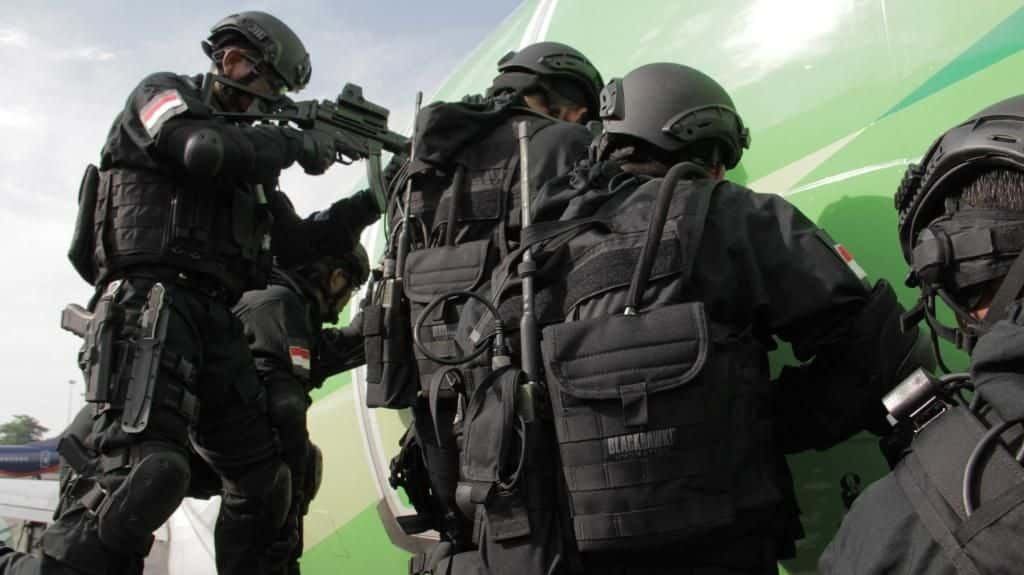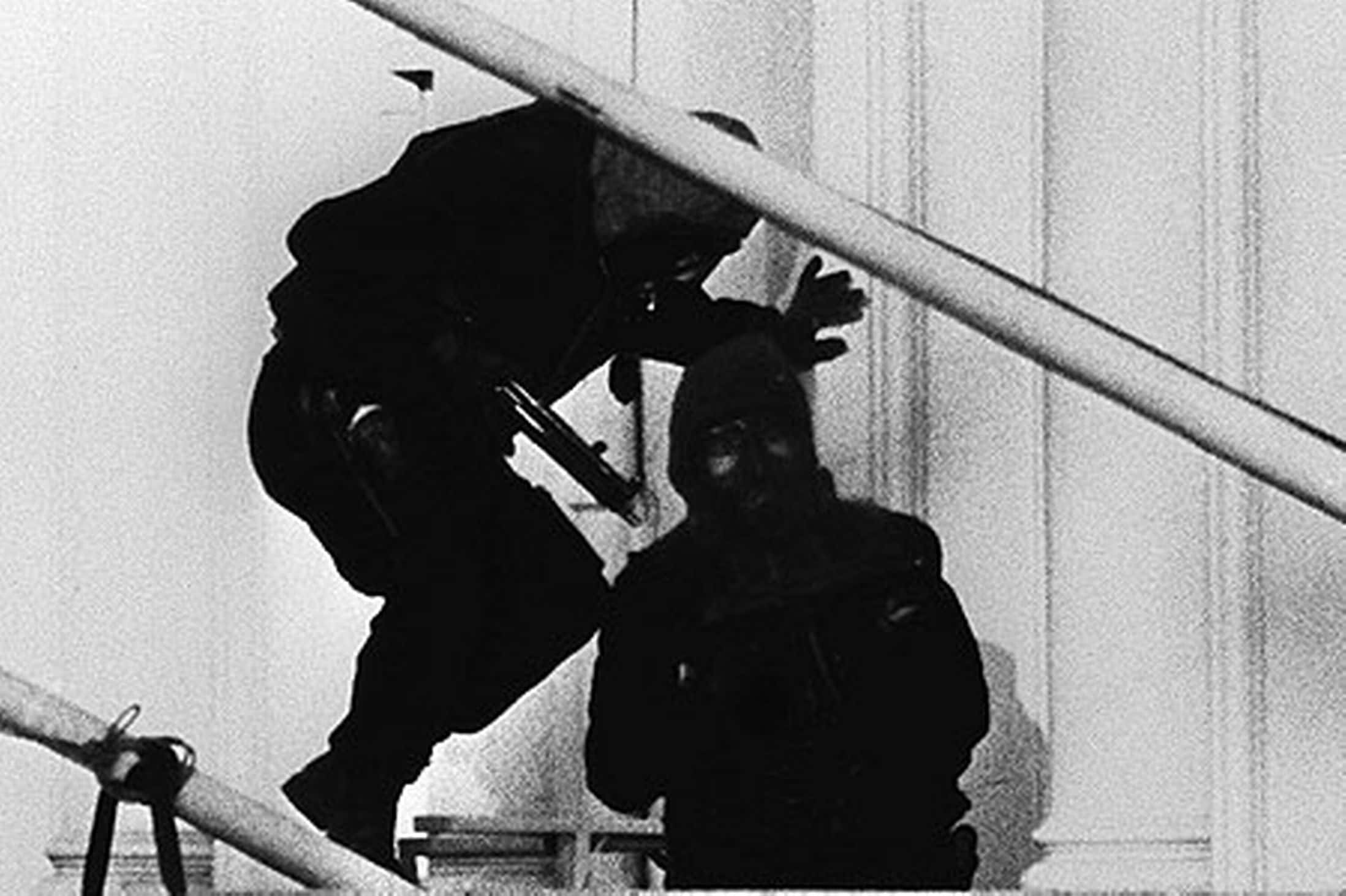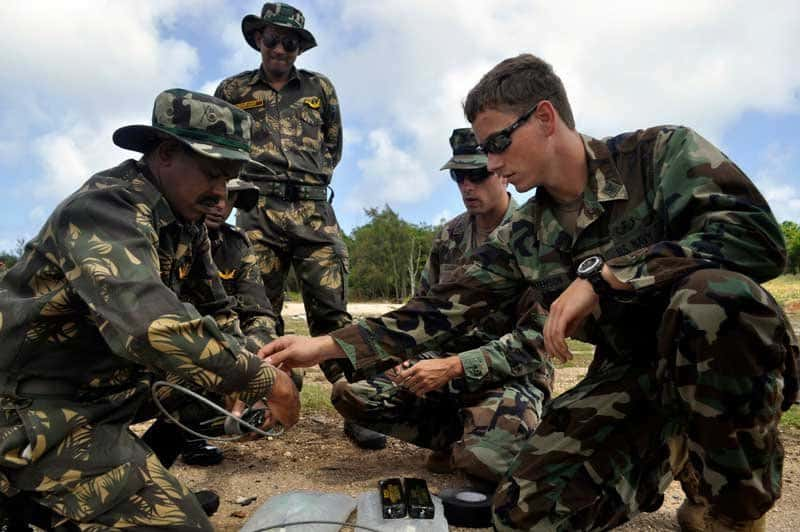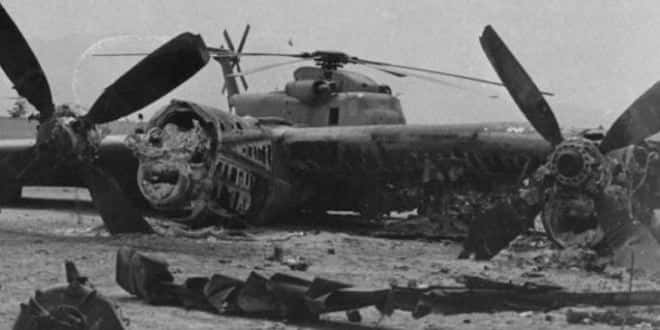“The SAS is the most elite of the special forces in the world. They are not people who go out and advertise; they keep it inside. They don't want anybody to know about them.”—Taylor Hackford.
The best of the best, the cream of the crop, the meanest of the mean—elite specials forces are nothing to mess with. Despite the secrecy that surrounds these special units, they have become a mainstay in today’s popular culture hivemind. Stories of impossible feats, daring rescues, grueling training, and startling cunning fill our television and movie screens, and regularly end up in the daily headlines. But what do we really know about some of the world’s most elite special force squads? Our list goes behind enemy lines to find the most death-defying elite force facts.
Elite Special Forces Facts
42. Family Man
Despite the intensity and travel requirements of their jobs, the average US Special Ops officer is 34 years old, married, and has two kids.
41. The British Inspiration for the Green Berets
The US Special force known as the Green Berets are well known for their guerrilla tactics and their work in Vietnam. But where did the green beret come from? It was, in fact, a morale-building tool introduced as a reference to British commandos during WWII. The US force that would come to be known as the Green Berets wore these signature hats during their initial training and not in combat, until President Kennedy recognized and expanded their role and asked them to wear the beret officially.
40. Beret Buds
Perhaps also drawing inspiration from the British Green Berets, the Turkish Army has a special force unit that wears berets. Instead of green, the Turkish troops sport their signature cap in a maroon hue; unofficially, this unit is referred to as the Maroon Berets.
39. L Detachment
The UK Special Air Service, or SAS, is one of the most well known special force units in operation today, but surprisingly they were never supposed to be a permanent unit. Originally and mysteriously called “L Detachment” to keep Nazis off their trail, the proto-SAS unit was disbanded after their work in WWII. Unfortunately, the necessity of their existence was quickly made clear, and SAS was rebranded and reunited only a year later. Today, L Detachment now refers to the ex-regular SAS regiment soldiers who form the unit’s reserves.
38. SAS Secrets
Not too much was known about the SAS early days until the 1990s, when a SAS member donated his diary from the second world war to the SAS regimental association. It contained original SAS documents, photographs, and accounts of the war—a treasure for SAS historical buffs. It was recently published in a small run to fundraise for the association.
37. Beard-O
The first thing anyone thinks of when the picture a soldier is the crew cut and clean shave. But a special forces operative? Typically, they follow a more relaxed rule set that allows them to adjust their appearances to match the environment they are serving in, and for many that means they can rock the beard—a rarity for the armed forces.
36. Mental Hell Week
The Navy SEALS are among the best special forces out there but getting into the highly specialized group isn’t easy. Trainees must pass a grueling competition known as hell week, which forces them to withstand freezing cold ocean water, carry impossible loads through muddy paths and endure many other kinds of mental and physical hardships. Trainees are kept sleep deprived but must stay focused through a range of obstacles—from hypothermia to hallucination—and during a constant barrage of discouragement from instructors who are looking to weed out those who don’t have the burning desire to be a SEAL. Making it through Hell Week is designed to make a future Seal to feel they can overcome the impossible.
35. Daring Beginnings
Like the US Navy SEALS, the UK Special Boat Service, or the SBS, is a highly elite special force especially adept at navigating water environments. The SBS was supposedly started when a British commando felt that his overseers were not taking advantage of his stealthy over-water abilities. He took it upon himself to sneak on to a UK Navy ship, steal a gun, and leave his initials on the captain’s door. After this stunt the British Navy gave him a unit, and the Special Boat Service has been in operation since.
34. Contract Work
Not ones to let their elite training and special skills go to waste in retirement, many former-SAS operatives found a second life in action as bodyguards to businessmen, contractors and experts who were called in to help rebuild Iraq after the Iraq War. Some of the ex-military men were paid up to £1,000 a day for their services.
33. Not Just for Combat
US Special Forces are not only deployed in combat or enemy missions; their special skills are often needed in times of humanitarian crisis. They were there to help after avalanches in Afghanistan, tsunamis in Japan, and earthquakes in Nepal and Haiti.
32. “Night Stalkers Don’t Quit”
That’s the Night Stalker motto—a special US Army helicopter force that is responsible for getting into places thought to be impossible to get to, and for getting in undetected. The Night Stalkers are called in when backup is needed, either for supplies, reinforcement, or rescue—in this way the rest of the Army relies on this specially trained air unit.
 Pinterest
Pinterest
31. Underwater Work
One unique job taken on by special forces units in Greece and in the US are the Underwater Demolition Teams. While the Navy SEALS and the Special Boat Service are skilled on water, the Demolition Teams have a more specific focus—they blow things up on and under water.
30. Its All in the Look
The Pakistani special forces unit is nicknamed “The Black Storks.” This is because the commandos wear black headgear which covers their faces and makes them look extremely intimidating.
29. World on your Back
The US Special Ops are required to be able to carry all their supplies with them if necessary on a mission. This can include up to 100 pounds of gear, the most important of which, such as knives, grenades, GPS, and flashlights, must be kept in their pockets for quick retrieval.
28. Out of the Loop
To do their job properly, special forces must keep a low profile and complete their missions under total secrecy. This was never more apparent than in the early days of the Afghanistan war; the Canadian special ops unit known as the Joint Task Force 2 was deployed but only a very few knew about it—even the Canadian Prime Minister was in the dark.
27. The First Rule of Delta Force…
Don’t talk about Delta Force. Seriously though, this US Army shadow force is not officially recognized, and any member of that force who lets information out is doing so at the risk of imprisonment. This highly secretive elite force is supposedly responsible for taking out Saddam Hussein, but nothing is known for sure… and I’ve already said too much…
26. News Ban
Similar to Delta Force, France’s National Gendarmerie Intervention Group (GIGN), known for their skill in attending to delicate hostage situations, also has to maintain an intense veil of secrecy around its members and operations. In this goal all of France is held to task—it is forbidden to print pictures of the faces of any of the GIGN.
 Pinterest
Pinterest
25. North Korean Tech
Not a lot is known about the North Korean elite forces, however they are thought to have several advanced technologies such as hovercrafts and biological weapons. However, one North Korean elite force seem to prefer to stick to more traditional machines; they use a small wooden soviet plane first created in 1947.
24. Cherry on Top
The Israeli Army has an elite special force known as Duvdevan, or “Cherry” in English. This team excels in independent undercover missions, often dressing in disguise and operating in urban areas. They are the best of the best, carrying out complex and dangerous intelligence missions. Why are they called cherry? It’s the “fruit at the top of the tree.”
23. The Gurka Regiment
Historically the Gurkas were an elite Nepalese combat unit that battled colonizers in the days of the East India Trading Company. When peace was arranged, the Brits invited the Gurkas to combine forces, and ever since there has been a Gurka regiment in the British army. These special soldiers still hail from Nepal and are trained in the traditional Gurka fighting techniques, which include using a traditional knife called a kukri.
 YouTube
YouTube
22. A Soldier and a Scholar
The US Special Forces has their very own university. It is called the Joint Special Operations University and is located in Florida. Admission is free to students in the armed forces.
21. Team Players
To encourage team cohesion, US Special Forces often play team sports, such as football or water polo. Often, they are even trained by Olympic-level athletes—only the best for the best!
20. Bravo!
Special forces are often known for focusing on one skill that they do better than anyone—the Air service is great in the Air, the Boat service handles water environments. For the Bravo Detachment 90, of the Indonesian Air Force, their special skill is in paralyzing enemy equipment. This includes deactivating bombs as well as taking over hijacked airplanes. Bravo, Bravo!
 Pinterest
Pinterest
19. No, it's Not Halloween…
The Peruvian Army special forces have a unique take on combat uniforms. Along with the traditional camouflage coats and beige helmets, these troops sometimes up the drama and the intimidation by painting their faces into the image of a skull.
 Have The Cows Come Home Yet? - WordPress
Have The Cows Come Home Yet? - WordPress
18. Innovative Impact
The US military is well known for developing new technologies that later trickle down into the public sector. Many of these technologies were developed for and by the Special Operations Units, such as a SharkBite Kit and freeze-dried plasma, which is used in treating injuries.
17. Special Weapons
To respond to the specific and terrifying threat of chemical, biological, radiological, and nuclear attacks, the Canadian Armed Forces have a special operations unit ready. They are called the Canadian Joint Incident Response Unit and they were established after 9/11.
16. Not all Brawn
To be in the US Special Forces requires a lot of physical strength, endurance, and survival skills, but it isn’t all you need. The US Army also requires that soldiers at this level become proficient in a second language that will be useful to their mission—quite a feat alongside all the demanding training!
15. Killer Commandos
Coming from the Hindi word for “killer” or “lethal,” the Indian Army’s special force unit is called the Ghatak Force. Their special role is to do complex reconnaissance, raids, and attacks on targets deeply tucked within enemy bounds.
14. Dedication to the Cause
Sometimes special mission requires special circumstances. When aiding the Saudi army to recapture the Grand Mosque in Mecca in 1979, the French special force, the GIGN, encountered a unique problem: non-Muslims were not allowed to enter the holy city. To get around this obstacle, the GIGN team all converted to Islam for a short time.
13. Swims like a Frog?
The term “frogman” is commonly used to refer to combat divers in special forces all over the world. The term refers to someone specially trained in underwater tactical work, such as underwater combat. The word came from the theater originally and was claimed by US Navy diver John Spence because he wore a green dive suit.
12. The Animal Kingdom
South Korea’s Army has a complex array of special force units, all with their own skills in unconventional warfare. Each brigade even has its own intimidating code name, including Eagle, Flying Tiger, Golden Bat, Ghost, and Pegasus. The newest brigade is an assassination unit, otherwise known as the “decapitation unit.” The new unit’s code name? Black Panther.
11. Not Your Average Weather Man
They don’t get as much attention as the Navy SEALS, but the US SOWT, or the Special Operations Weather Technicians, play an important role in many missions. The weather team is responsible for tracking the weather in remote or unstable locations, especially where local weather services can’t be relied upon. They are experts on navigating dangerous weather conditions and can make judgements on the spot to help leadership decide the timing and execution of all kinds of maneuvers. Their motto? “Eyes forward!”
 Boot Camp & Military Fitness Institute
Boot Camp & Military Fitness Institute
10. Too Many Cooks
There was a time when special forces in the US were so special that they didn’t even know what each other was up to. During the Iranian hostage crisis in the 1980s, the failure of Operation Eagle Claw was likely due in part to the fact that the special operations units, which included the Delta Force, were not communicating well with each other, and this lack of coordination led to a botched mission.
9. God-like
Many special forces have unique names like Cobras, Rangers, or SEALS—but there might not be a more well-suited name for an elite air squad than the Indian Air Force’s Garud Commando Force. Garud is a name derived from Hindu mythology—Garuda is the divine bird-like creature which the Hindu god Vishnu rides.
8. International Coverage
The US special ops may be one of the best in the world, and in fact, they can be found all over the world. As of 2015, US special ops were operating in 147 different countries—that’s 75 percent of the globe!
7. Allied Forces?
Although the UK SAS and SBS often work together and rely on one another for support, these two special elite teams have not always gotten along so well. During the beginning of the Iraq War, a fight broke out between the forces after a former SAS member bad-mouthed the SBS in the news media. This member claimed that the SBS was not as rigorously trained as the SAS, which led to the SAS often having to finish SBS missions. Of course, this led to SBS fighting back and verbally attacking SAS to the public. Eventually, British military higher-ups stepped Elite Special Forces Factsin and put a ban on insulting other forces.
6. Girl Power
The first modern special forces made up entirely of women is the Jegertroppen of the Norwegian Army. The force was created when commanders saw a need to put special female operators in urban regions to gather intelligence and build community with local women. The unit was created as a one-year pilot in 2014 and in 2017 declared a success. No women from the unit have been officially deployed yet.
5. Expat Army
During World War II, the Polish army operated in exile from Great Britain, while Poland was occupied by the Nazis. In this desperate time, the army created an elite team of paratroops to be secretly parachuted into occupied Poland. The team’s name was Cichociemni—or “Silent Unseen.” Today the Polish Army honors those that fought as the Silent Unseen in their current elite force, which is named in its honor.
4. SAS to the Rescue
One historic moment in the UK SAS history took place on local soil, in the heart of London itself. In 1980, an Iranian terrorist group took 26 people hostage at the Iranian embassy in London and threatened to kill them if their demands were not met. After six days of refusing to negotiate with terrorists, Margaret Thatcher, then Prime Minister, gave the go-ahead to SAS who was on call nearby. SAS successfully freed the hostages and captured some of the terrorists alive for questioning.
 pinterest
pinterest
3. Dark Training Games
Most special forces have unique and demanding training programs that would be torture for a regular civilian, but perhaps no training program beats the Russian Spetsnaz in its cruelty. In a tell-all published in 1985, a defected Russian agent reported matches to the death as part of Spetsnaz training. According to the agent, at this time the Russian forces would use prisoners from the Gulag as opponents and engage them in to-the-death combat.
2. Domestic Responsibilities
A particularly dark time in the UK Special Air Service’s history was during the Troubles in Northern Ireland. Throughout the ‘70s and ‘80s, an SAS unit was involved in investigations into the IRA and at times this involvement had dire consequences due to the ill-fit of their combat style to the delicate domestic situation. One tragic incident saw SAS mistakenly killing a teenage boy who, by chance, happened across a stash of IRA weapons. The SAS role in the Troubles has remained controversial ever since.
1. A Culture of Death
The SAS has recently been criticized by the parents of former applicants—applicants who tragically died during the extreme SAS recruit vetting process. In 2013, three soldiers died on the strenuous 16-mile march that is required by the SAS selection process. According to testimony at the inquest that followed, leadership around the march seemed unwilling to attend to serious health needs of the soldiers, however, no criminal charges were brought.
Sources: 1, 2, 3, 4, 5, 6, 7, 8, 9, 10, 11, 12, 13, 14, 15, 16, 17, 18, 19, 20, 21, 22, 23, 24, 25, 26, 27, 28, 29, 30, 31














































